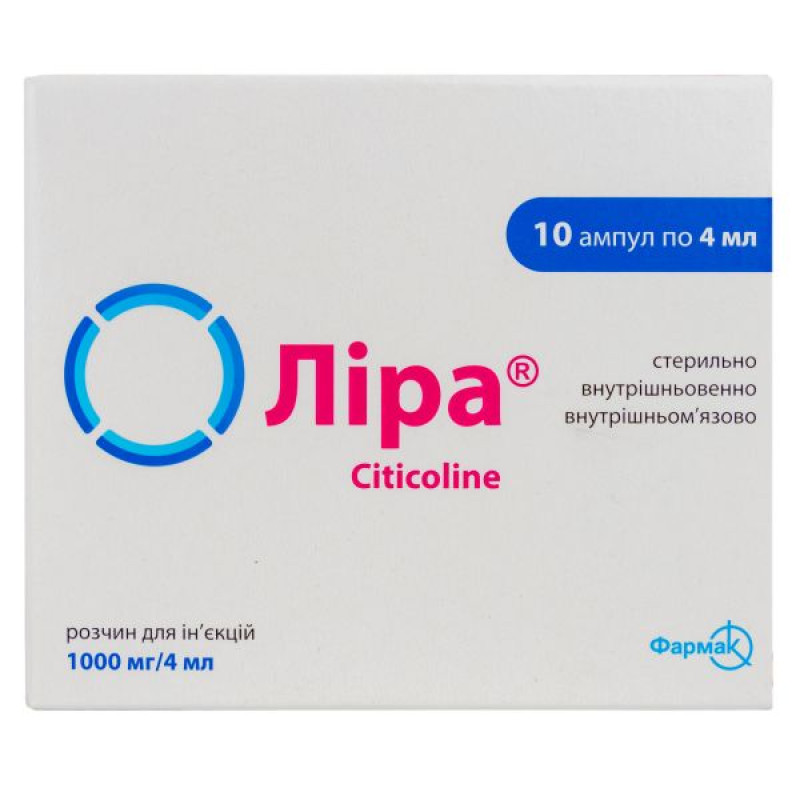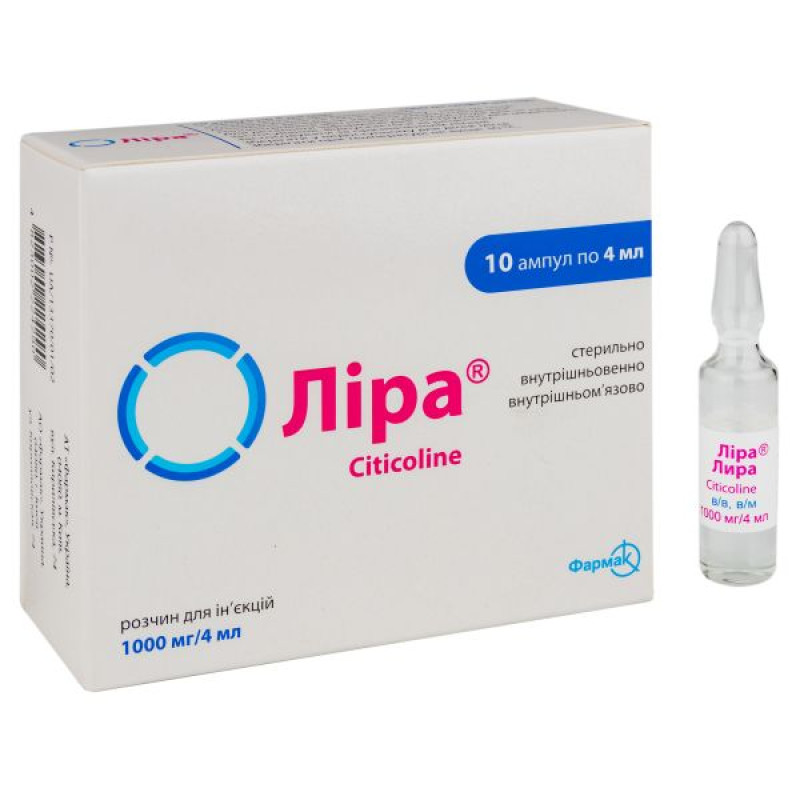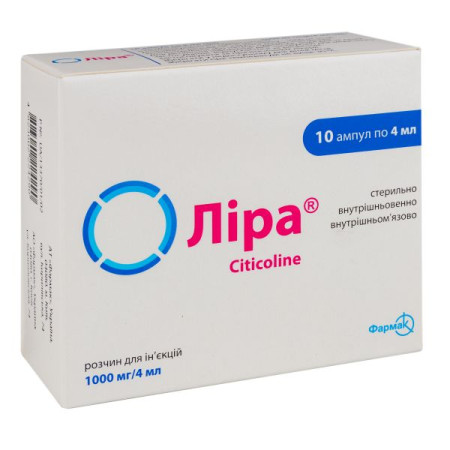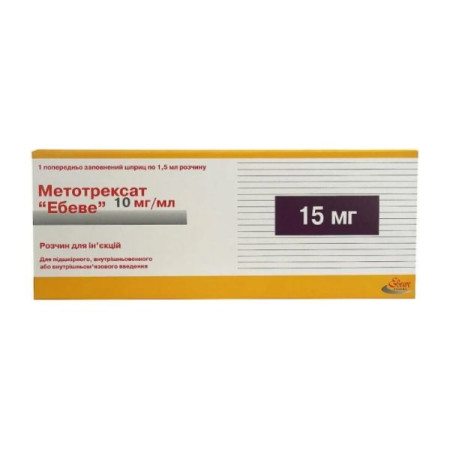Lyra solution for injection 1000 mg/4 ml ampoule 4 ml in blister No. 10
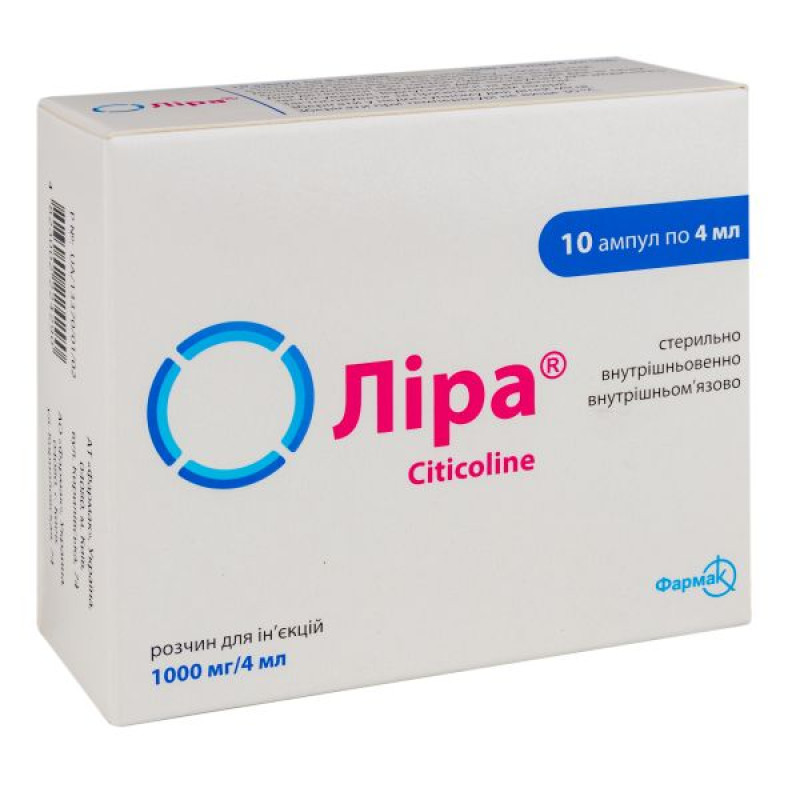
Instructions for use Lyra solution for injection 1000 mg/4 ml ampoule 4 ml in blister No. 10
Composition
active ingredient: citicoline;
1 ampoule (4 ml) contains 500 mg or 1000 mg of citicoline sodium in terms of 100% substance;
Excipients: concentrated hydrochloric acid or sodium hydroxide, water for injection.
Dosage form
Solution for injection.
Main physicochemical properties: clear colorless or slightly yellowish liquid.
Pharmacotherapeutic group
Psychostimulants and nootropics. ATX code N06B X06.
Pharmacological properties
Pharmacodynamics.
Citicoline stimulates the biosynthesis of structural phospholipids in the membrane of neurons, which is confirmed by magnetic resonance spectroscopy. Citicoline improves the functioning of such membrane mechanisms as ion pumps and receptors, without the regulation of which normal conduction of nerve impulses is impossible. Due to its stabilizing effect on the membrane, citicoline has anti-edematous properties, therefore it reduces brain edema. The results of studies have shown that citicoline inhibits the activity of some phospholipases (A1, A2, C and D), prevents the residual release of free radicals, prevents damage to membrane systems and ensures the preservation of the protective antioxidant system.
Citicoline preserves neuronal energy reserves and inhibits apoptosis, which improves cholinergic transmission.
Citicoline also has a preventive neuroprotective effect in focal cerebral ischemia.
Citicoline promotes rapid functional rehabilitation of patients with acute cerebral circulation disorders, reducing ischemic damage to brain tissue, which is confirmed by the results of X-ray studies.
In case of traumatic brain injuries, citicoline shortens the duration of the recovery period and reduces the intensity of post-traumatic syndrome.
Citicoline improves attention and state of consciousness, helps reduce the manifestations of amnesia, and improves the condition of cognitive and other neurological disorders observed with cerebral ischemia.
Pharmacokinetics.
Citicoline is well absorbed after oral, intramuscular and intravenous administration. After administration of the drug, a significant increase in the level of choline in the blood plasma is observed. When administered orally, the drug is almost completely absorbed. Studies have shown that the bioavailability after oral and parenteral administration is almost the same.
The drug is metabolized in the intestines and liver to form choline and cytidine. After administration, citicoline is absorbed by brain tissues, with cholines acting on phospholipids, cytidine on cytidine nucleoids and nucleic acids. Citicoline quickly reaches brain tissues and is actively incorporated into cell membranes, cytoplasm and mitochondria, activating the activity of phospholipids.
Only a small amount of the administered dose is excreted in the urine and feces (less than 3%). Approximately 12% of the dose is excreted in exhaled CO2. There are two phases in the excretion of the drug in the urine: the first phase is approximately 36 hours, in which the rate of excretion decreases rapidly, and the second phase, in which the rate of excretion decreases much more slowly. The same phasic pattern is observed in the excretion of exhaled CO2, the rate of excretion decreases rapidly for approximately 15 hours, then it decreases much more slowly.
Indication
Stroke, acute phase of cerebrovascular disorders and treatment of complications and consequences of cerebrovascular disorders.
Traumatic brain injury and its neurological consequences.
Cognitive and behavioral disorders due to chronic vascular and degenerative cerebral disorders.
Contraindication
Hypersensitivity to any component of the drug.
Increased tone of the parasympathetic nervous system.
Interaction with other medicinal products and other types of interactions
The drug should not be used simultaneously with drugs containing meclofenoxate. Enhances the effect of levodopa.
Application features
In case of persistent intracranial hemorrhage, the dose should not exceed 1000 mg per day and the intravenous infusion rate should not exceed 30 drops per minute.
Use during pregnancy or breastfeeding
There are no adequate data on the use of Lyra® in pregnant women. There are no data on the excretion of citicoline into breast milk and its effect on the fetus. Therefore, during pregnancy or breastfeeding, the drug should be prescribed only if the expected benefit to the mother outweighs the potential risk to the fetus.
Ability to influence reaction speed when driving vehicles or other mechanisms
In some cases, some adverse reactions from the central nervous system may affect the ability to drive or operate complex machinery.
Method of administration and doses
The drug should be used for intravenous or intramuscular administration, administered intravenously in the form of a slow intravenous injection (over 3-5 minutes, depending on the prescribed dose) or intravenously drip (40-60 drops per minute).
The maximum daily dose is 2000 mg.
In acute and emergency conditions, the maximum therapeutic effect is achieved when the drug is administered in the first 24 hours.
The duration of treatment depends on the course of the disease and is determined by the doctor.
No dose adjustment is required for elderly patients.
The drug is compatible with all intravenous isotonic solutions, as well as with hypertonic glucose solutions.
This solution is for single use only. The solution should be administered immediately after opening the ampoule. Any unused solution should be discarded.
If necessary, treatment is continued with the drug in the form of a solution for oral administration or tablets.
Children.
Experience with the drug in children is limited, so the drug should only be prescribed when the expected benefit outweighs any potential risk.
Overdose
Cases of overdose have not been described.
Side effects
Very rare (< 1/10,000) (including patient reports).
From the side of the central and peripheral nervous systems: severe headache, vertigo, hallucinations.
From the cardiovascular system: arterial hypertension, arterial hypotension, tachycardia.
Respiratory system: shortness of breath.
From the digestive tract: nausea, vomiting, diarrhea.
On the part of the immune system: allergic reactions, including: rash, hyperemia, exanthema, urticaria, purpura, itching, angioedema, anaphylactic shock.
General reactions: chills, changes at the injection site.
Expiration date
2 years.
Do not use the drug after the expiration date indicated on the package.
Storage conditions
Store at a temperature not exceeding 30 °C.
Keep out of reach of children.
Incompatibility
Do not use solvents not listed in the “Method of administration and dosage” section.
Packaging
4 ml in an ampoule. 5 or 10 ampoules in a pack.
Vacation category
According to the recipe.
Producer
JSC "Farmak".
Address
Ukraine, 04080, Kyiv, Kyrylivska St., 74.
There are no reviews for this product.
There are no reviews for this product, be the first to leave your review.
No questions about this product, be the first and ask your question.




